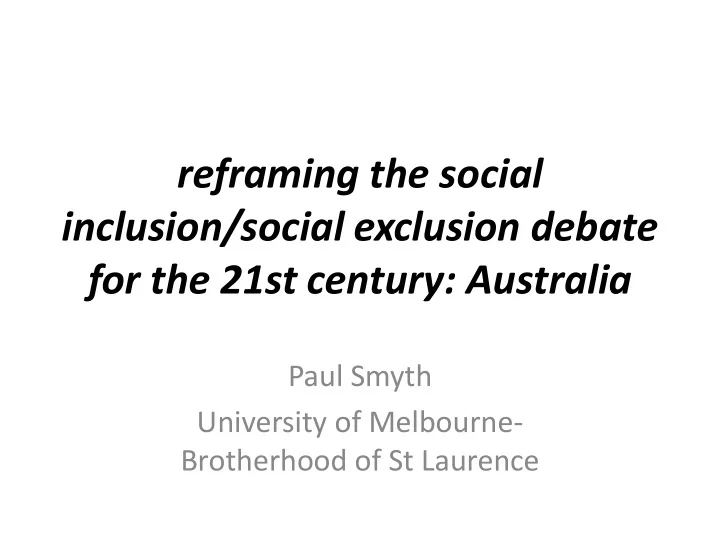

reframing the social inclusion/social exclusion debate for the 21st century: Australia Paul Smyth University of Melbourne- Brotherhood of St Laurence
New century: new paradigm Welfare in 1990s: • A poverty war : ‘end’ Versus ‘save’ welfare as we know it Ending the stalemate: • Continued high social spending (Howard) • Postcode poverty • The social capital moment • Ec boom with underutilised labour
From welfare to social investment • Rethinking disadvantage (Sen) • Eg ‘social barometer’: children’s chances • The ‘Third Wave’ of economic reform • The ‘3 Ps’ participation \ productivity\ population • ‘long tails of under - achievement’ • Fired up by Ageing society\ skills shortages
benefits of the education and training part of NRA
Investing in social inclusion? • Multidimensional \cumulative • Focus on what people are enabled to do and be • Recognise people value different things • Identify the threshold of resources individuals\ communities need to realise social and economic capabilities
Restating the welfare goal • ‘An equal society protects and promotes equal real freedom and substantive opportunity to live in the ways people value and would choose, so that everyone can flourish. An equal society recognizes people’s different needs, situations and goals and removes the barriers that limit what people can do and be’ (UK’s EHRC, 2007)
Varieties of social inclusion liberal social democratic • Conception of integration specialisation monopoly • Source of integration exchange citizenship • Ideology liberalism social\democratic • Discourse underclass inequality • Thinkers Locke \Smith Marx\Marshall • Social policies Residual (charity) Universal (state)
‘big society or ‘social investment state’ • big society: help underclass trapped in dependency, addiction, debt and family breakdown by private charity and family help • ‘SI state’ : bring each citizen to a threshold level of sufficiency in each capability (Sen); with conditions of mutual recognition\respect (Nancy Fraser)
Path Dependency: federation • “Workingmans’ Paradise” • Against the two tier society (Pember Reeves) • Regulate to spread opportunity (land; infrastructure; services) • Invest in competitiveness: high wage path • provide a fair go: Harvester judgement (living wage) • Against government welfare (Poor Law)
Welfare reform:WW2 1. industrial rights prevented exploitation and gave lower paid workers ‘a fair share in the product of their industry’; 2. social services ‘to give effect to the popular democratic belief that every individual should have as good an opportunity in life as his neighbor’. 3. assistance for the poor.
1 st national welfare plan • “The trapeze artist’s net protects him through the whole course of his flight. The net is not, of course, part of the main show; that goes on high above, and the higher it goes, the better we enjoy it. So it is with social security.” • The ‘main show’ was full employment and growth • ‘Social security’ a by - product of ‘increasing abundance’, equitably redistributed.
Today • Wage earners welfare : ‘of historical interest only’ • Social services: public as second class services for second class citizens • Income support (unemployment\ sole parents) less social protection than 1 st encounter with poverty
A New Social Contract • New economic and social rights for the 21 st century • A Contract for a Competitive Economy • A Contract for an Inclusive Society
An inclusive society across the life course Identify the threshold of resources people need to realise social and economic capabilities across life course: • early years • school to work • working years • retirement- ageing For each: new entitlements\\ new obligations
An inclusive society in a competitive economy • Against two tier economy = create more and better jobs • strategy beyond ‘rocks and crops’ • tackle ‘low skill traps’ • high performance management practices • national training standards • R and D support for business to close gaps on competitors • Invest in firms with high innovation potential
Flexibility with security • active labour market programs • life long learning systems • adequate income support (insurance?) • Work-life balance
Recommend
More recommend